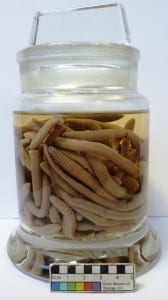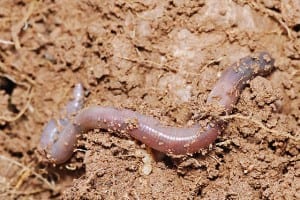Specimen of the Week 234: Jar of Earthworms
By Dean W Veall, on 11 April 2016
Hello to you all out there on the interwebs. Dean Veall here. My specimen of the week is another in the ‘Jar Of’ series, admittedly a series of one so far, but a series. Right. This is a bit of delayed SoTW due to the enforced shut down of Grant Museum Towers by our beloved overlords, so apologies if you missed your regular Friday fix. This week’s Specimen of the Week is…..
**A jar of earthworms**
1). Who run the world? Earthworms
Earthworms belong to a group of invertebrates known as annelid worms and is a generic name for what is in fact around 6,000 different species of these worms. In the UK we are most likely to come across around 14 different species including the lob worm (Lumbricus terrestris) or the grey worm (Aporrectodea calignosa). These worms may look insignificant but play a vital role creating rich fertile soils within terrestrial ecosystems by digesting organic material from the surface and taking it underground. The physical nature of burrowing by these soil engineers also help oxygen and water to penetrate the soil which in turn creates great conditions for underground bacteria and fungi allowing healthy cycling of nutrients in the soil.
2). Rum Earthworms
A month ago the Telegraph reported the ‘nightmarish’ scenario of the GIANT Rum earthworm. Putting aside the horrific prejudice against this incredibly useful group of invertebrates, the article presented fascinating discovery by Dr. Kevin Butt from the University of Central Lancashire’s Earthworm Research Group. They found that living on the Scottish island of Rum were earthworms that were three times the length and weight of those found in the rest of the UK. Dr. Butt found individuals that were over 40cm long and weighed 12.5g, WHOPPERS indeed. It has been thought that they were able to grow to this enormous size due to a combination of factors such the isolation from the main land (resulting in lack of predators such as badgers and foxes), rich high quality soil and lack of human disturbance. The Giant Earthworms of Rum…. sounds like a title you might expect to find in a Professor Joe Cain film night.
3). The DADDY of all earthworms
The Rum earthworms are big but not as big as the giant Gippsland earthworm. These Australian annelids average 1m but get up to 3m and weigh a humongous (by earthworm standards) 200g. Sadly, due to compaction of the soil by introduced cattle these amazing invertebrates are now vulnerable to extinction and are considered a protected species.
4). Soil Survey
If you want to know more about earthworms and get your hands dirty check out OPAL’s Soil Survey and have a go at identifying some earthworms. This great project is helping to understand more about these incredible invertebrates and the soil they live in. Who knows you may even find your own giant in your local green space.
Dean Veall is Learning and Access Officer at the Grant Museum of Zoology
 Close
Close



